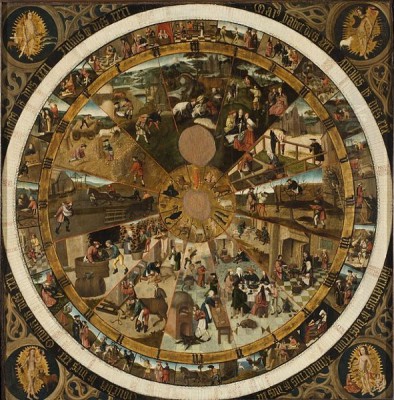
Jan Massys stands as a significant yet sometimes overlooked figure in the rich tapestry of the Northern Renaissance. Active during a period of profound religious, social, and artistic transformation, he navigated a complex world, inheriting a renowned artistic legacy while forging his own distinct path. Born into the heart of Antwerp's thriving art scene around 1510, Jan was the son of the celebrated painter Quentin Massys, a foundational figure in the Antwerp school. His life, marked by artistic inheritance, religious persecution, exile, and eventual return, shaped a unique artistic vision that blended the meticulous realism of the Flemish tradition with the elegant sensuality of Italian and French Mannerism. His work, particularly his refined depictions of biblical and mythological heroines, serves as a fascinating bridge between the artistic worlds of Northern and Southern Europe in the 16th century.
Early Life and Artistic Formation in Antwerp
Jan Massys entered the world in Antwerp, a city rapidly becoming one of Europe's most important commercial and artistic hubs. His father, Quentin Massys (c. 1466–1530), was arguably the city's leading painter at the time, renowned for his ability to synthesize the detailed naturalism of earlier Netherlandish masters like Jan van Eyck and Rogier van der Weyden with emerging Renaissance ideals, including emotional depth and psychological insight. Quentin's works, ranging from poignant religious scenes like the Lamentation Altarpiece to incisive portraits and genre scenes such as the famous Moneylender and His Wife, set a high standard and established a busy, successful workshop.
It was within this dynamic environment that Jan received his formative training. Working alongside his father, he would have absorbed the meticulous techniques of oil painting characteristic of the Flemish school – the careful rendering of textures, the luminous use of color, and the attention to detail. He likely assisted on workshop commissions, learning the family trade firsthand. Upon Quentin's death in 1530, Jan, along with his elder brother Cornelis Massys (c. 1510/11–c. 1556/57), who became known primarily for his landscapes and genre scenes, inherited the workshop's mantle.
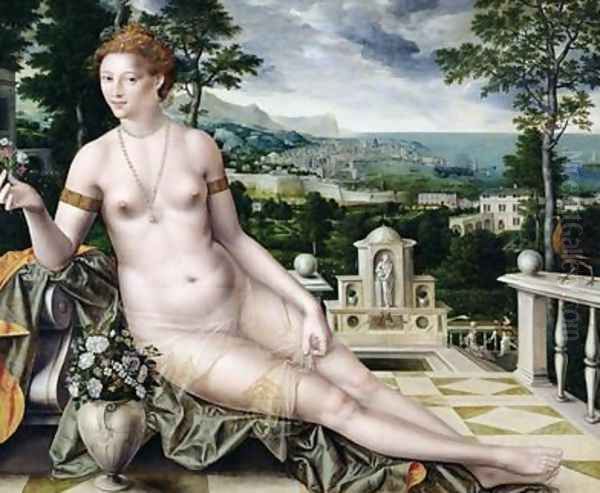
In 1531, both Jan and Cornelis were formally admitted as masters into the prestigious Antwerp Guild of Saint Luke, a crucial step confirming their status as independent professional artists. In these early years, Jan likely continued working in a style close to his father's, perhaps collaborating with Cornelis on certain projects. While definitive works from this initial period are scarce, it is assumed he honed his skills, fulfilling commissions and establishing his own reputation within the bustling Antwerp art market, building upon the strong foundation laid by his father.
Religious Turmoil and Years of Exile
The mid-16th century in the Low Countries was a period of intense religious upheaval. The Protestant Reformation, sparked decades earlier, had gained significant traction, challenging the authority of the Catholic Church and leading to widespread social and political tension. Antwerp, despite its commercial success, was not immune to these conflicts. Various reformist groups emerged, often facing persecution from the Habsburg authorities under Emperor Charles V, who sought to maintain Catholic orthodoxy in his territories.
Jan Massys found himself caught in these dangerous currents. Records indicate that in 1544, he was banished from Antwerp due to his association with Protestant or reformist beliefs, possibly linked to a group known as the Loists. This expulsion marked a dramatic turning point in his life and career, forcing him to leave his home city and seek refuge abroad for over a decade. The exact itinerary of his exile remains somewhat uncertain, but it is widely believed that he spent time in both France and Italy.
His travels likely brought him into direct contact with the latest artistic developments south of the Alps. France, particularly the court of Francis I at Fontainebleau, was a major center where Italian artists like Rosso Fiorentino and Francesco Primaticcio had established a sophisticated Mannerist style, characterized by elongated figures, complex poses, and erotic undertones. A stay in Italy, perhaps in cities like Genoa, Florence, or even Rome, would have exposed him directly to the works of High Renaissance masters such as Leonardo da Vinci, Raphael, and Michelangelo, as well as contemporary Mannerist painters like Bronzino and Parmigianino. This period of forced travel, while personally challenging, proved artistically transformative.
The Influence of Italy and France
The years spent away from Antwerp profoundly reshaped Jan Massys's artistic sensibilities. While he never fully abandoned his Northern heritage of detailed observation, his exposure to Italian Renaissance and Mannerist art, along with the stylish elegance of the School of Fontainebleau, introduced new elements into his work. He began to adopt the elongated proportions, graceful S-curve poses (figura serpentinata), and sophisticated, often ambiguous, compositions characteristic of Mannerism.

Perhaps the most notable impact was on his treatment of the human figure, particularly the female nude. Italian art offered idealized yet anatomically convincing models, while the Fontainebleau school specialized in a refined, courtly eroticism. Massys absorbed these influences, developing a distinctive approach to depicting biblical and mythological heroines. Figures like Venus, Bathsheba, Susanna, and Mary Magdalene became recurring subjects, rendered with a smooth, polished finish, pale skin, and an air of detached sensuality that blended Northern precision with Southern grace.
Works produced after his return, such as Venus Cythera (1561) and Bathsheba (1562), clearly demonstrate this stylistic fusion. The figures possess an idealized beauty and elegance derived from Italian prototypes, placed within compositions that often feature classical architectural elements or lush landscapes, yet retain a certain Northern clarity and detail in accessories or background elements. This synthesis marked him as a key figure among the "Romanists" – Northern artists who traveled to Italy and integrated Italian styles into their native traditions, alongside contemporaries like Frans Floris and Lambert Lombard.
Return to Antwerp and Mature Career
Around 1555, conditions apparently allowed Jan Massys to return to Antwerp. He rejoined the Guild of Saint Luke and set about re-establishing his workshop and career in his home city. The Antwerp he returned to was still a major art center, though religious tensions continued to simmer, eventually leading to the iconoclastic fury (Beeldenstorm) of 1566 and further conflict. Despite the potentially precarious environment, Massys seems to have found success during this later phase of his career, which lasted until his death around 1575.
His mature style represents a culmination of his life experiences: a sophisticated blend of the meticulous detail learned in his father's workshop and the elegant forms absorbed during his exile. He continued to specialize in religious and mythological subjects, often favoring scenes that allowed for the depiction of alluring female figures. His Virgin and Child paintings from this period (e.g., 1552, Brussels; 1556, Genoa) show a Leonardesque softness and sfumato applied to the tender subject, while the Holy Family (1563, Antwerp) displays a complex, Mannerist-inspired composition.
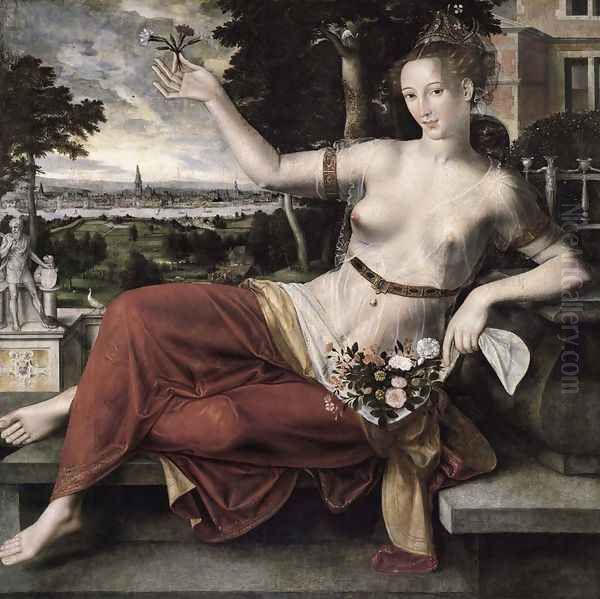
His famous Bathsheba (1562, Louvre) is a prime example of his mature work. Bathsheba is depicted with the characteristic pale skin, elongated limbs, and refined features, attended by servants in a setting that includes classical architecture and a detailed cityscape, showcasing his ability to merge different stylistic elements seamlessly. Venus Cythera (1561, Nationalmuseum, Stockholm) similarly presents a coolly elegant nude in a mythological guise, embodying the sophisticated, slightly artificial grace of Mannerism. He also continued to explore genre themes, sometimes with satirical undertones reminiscent of his father's work or that of contemporaries like Marinus van Reymerswaele, known for his caricatured depictions of tax collectors and lawyers.
Themes and Subject Matter
Jan Massys's oeuvre is characterized by a recurring focus on specific themes, primarily drawn from the Bible and classical mythology, often centered around prominent female figures. His choice of subjects reflects both traditional devotional needs and the growing humanist interest in classical antiquity, as well as a clear personal predilection for depicting the female form. Figures such as Bathsheba, Susanna, Judith, Lucretia, Venus, and the Penitent Mary Magdalene appear frequently in his work.
His treatment of these figures is notable for its blend of narrative context and sensual appeal. While ostensibly illustrating moral or religious stories, his paintings often emphasize the physical beauty and allure of the heroines. The nudity or semi-nudity is rendered with a smooth, porcelain-like finish, emphasizing elegant contours and graceful poses rather than overt realism or vulnerability. This approach aligns with Mannerist aesthetics, where sophistication and artifice were highly valued, sometimes creating a sense of emotional distance despite the potentially dramatic subject matter.
Alongside these elevated themes, Massys also engaged with genre painting, a field gaining prominence in the Netherlands. Works depicting tax collectors, merchants, or scenes of everyday life, sometimes carrying moralizing messages about greed or folly, connect him to a Northern tradition exemplified by his father, Quentin Massys, and later developed by artists like Pieter Aertsen and Joachim Beuckelaer, who pioneered large-scale market and kitchen scenes. Hieronymus Bosch and Pieter Bruegel the Elder also represent the strong Netherlandish interest in genre and moral allegory, providing a broader context for Jan's work in this vein.
Artistic Style and Technique
Jan Massys's style is a fascinating hybrid, reflecting his Northern training and Southern European experiences. Technically, he retained the meticulousness of the Flemish tradition. His paintings often feature carefully rendered details in fabrics, jewelry, architectural elements, and landscape backgrounds, executed with fine brushes and a smooth application of paint, achieving luminous effects through glazing techniques inherited from masters like Jan van Eyck.
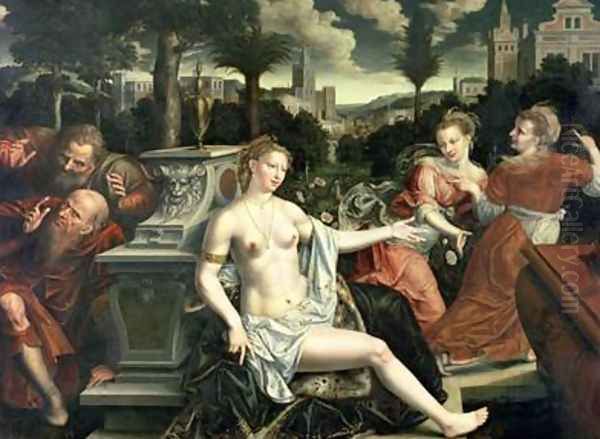
Superimposed on this Northern foundation are the hallmarks of Italian and French Mannerism. His figures typically display elongated proportions, small heads, and elegant, often complex, twisting poses (the figura serpentinata). Compositions are carefully constructed, often balanced but incorporating dynamic diagonals or spatial arrangements influenced by Italian models. He frequently employed classical architectural motifs or idealized landscapes, sometimes drawing on the panoramic traditions developed by earlier Flemish landscape specialists like Joachim Patinir, whose work Quentin Massys sometimes collaborated on.
His color palette often combines rich, jewel-like tones favored in Northern painting with the more harmonious or sometimes deliberately contrasting color schemes found in Mannerism. He mastered the use of light and shadow, employing subtle sfumato, particularly in flesh tones, reminiscent of Leonardo da Vinci, to create soft transitions and a sense of volume, while also using stronger chiaroscuro for dramatic effect where needed. The overall impression is one of refinement, technical skill, and a sophisticated, slightly stylized elegance that distinguishes his work from both his father's more robust realism and the burgeoning Baroque style that would follow.
Contemporaries and Context
Jan Massys operated within a vibrant and competitive artistic milieu in Antwerp, interacting with and responding to the work of numerous contemporaries. His most immediate artistic relationship was, of course, with his father, Quentin, and his brother, Cornelis. Beyond his family, he was part of a generation of Antwerp artists grappling with the influence of the Italian Renaissance. Key figures included Frans Floris (1519/20–1570), a highly influential painter and draftsman who ran a large workshop and was a leading proponent of Romanism, known for his muscular figures and dramatic compositions.
Other notable contemporaries included Pieter Aertsen (1508–1575) and his nephew Joachim Beuckelaer (c. 1533–c. 1575), who were developing innovative large-scale genre scenes, often embedding religious narratives within bustling market or kitchen settings. Lambert Lombard (1505–1566), active mainly in Liège but influential through his travels and teachings, was another important figure promoting Italianate classicism. Comparisons are often drawn between Jan Massys and Marinus van Reymerswaele (c. 1490–c. 1546), particularly in their shared interest in satirical genre subjects like tax collectors, though Massys generally employed a more refined style.
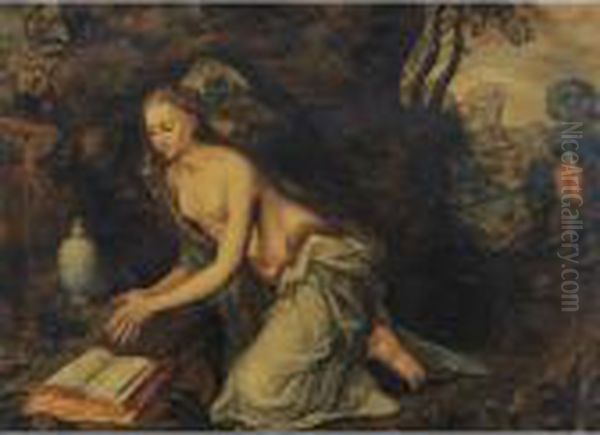
He would also have been aware of the legacy of earlier Antwerp masters like Joos van Cleve (c. 1485–1540/41) and the ongoing influence of landscape specialists like Patinir. The broader European context included the towering figures of the Italian High Renaissance and Mannerism – Leonardo, Raphael, Michelangelo, Titian, Bronzino – whose works Massys likely encountered directly or through prints during his exile. The elegant, decorative style of the School of Fontainebleau, shaped by Rosso Fiorentino and Primaticcio, also left an undeniable mark on his aesthetic.
Legacy and Influence
Jan Massys played a significant role in the transmission of Italianate and Mannerist styles to Northern Europe. As a second-generation member of the Massys dynasty, he built upon his father's legacy while adapting to the changing artistic tastes of the mid-16th century. His specialization in elegant, often sensuous depictions of female figures from mythology and the Bible proved popular and influential, contributing to a genre that would continue in Flemish and Dutch art.
His synthesis of Northern detail and Southern elegance provided a model for subsequent artists navigating the relationship between local traditions and international trends. While perhaps not as revolutionary as some of his contemporaries, his work represents a successful and sophisticated fusion that appealed to patrons seeking refined and fashionable art. His paintings were copied and disseminated, helping to spread his stylistic approach.
His artistic lineage continued through his son, Quentin Massys the Younger (c. 1543–1589), who also became a painter and master in the Antwerp guild before later moving abroad. While Jan Massys's fame may have been somewhat eclipsed by the towering figures of the later Antwerp Baroque school, such as Peter Paul Rubens and Anthony van Dyck, his contribution remains important. He represents a crucial link in the evolution of Flemish painting, demonstrating how artists absorbed and transformed foreign influences while retaining a connection to their own rich artistic heritage during a pivotal era of European art history. His work stands as a testament to a life lived across cultural boundaries and through turbulent times, reflected in an art of sophisticated, enduring appeal.